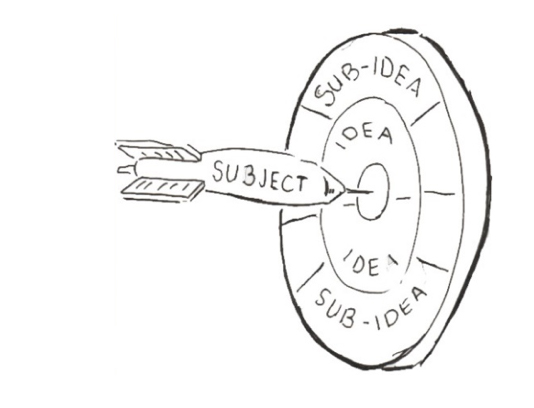Sort Articles:
Mind-Mapping
Written by: Ralph Twombly
Published: Tue Jan 26 2021 14:34:37 GMT-0500 (Eastern Standard Time)
“In the fields of observation chance favors only the prepared mind.”
~Louis Pasteur
 The more we teach this technique, the more people like it. We took it for granted for years because we used it so often, and it is still one of the best tools to bring the creativity out of a group. It taps into the visual and abstract sense that our brain feels is most appealing. Some simple rules you will find easy to apply:
The more we teach this technique, the more people like it. We took it for granted for years because we used it so often, and it is still one of the best tools to bring the creativity out of a group. It taps into the visual and abstract sense that our brain feels is most appealing. Some simple rules you will find easy to apply:
Hit the “bullseye”
- Start in the center placing your subject or problem with an image or words in the circle. Use colors.
- Place the different solutions (ideas) to the subject or problem around the outside as primary words directly connected to the center circle. Connect each idea or solution to the central image.
- Use images, symbols, codes, and dimensions throughout your mind map.
- Select key words and print in upper- or lower-case letters.
- Connect the different solutions (ideas) using a dotted line.
- For each idea or solution, start to collect detail and sub-ideas. Groups like to start to go to detail. Allow them to satisfy some of the things that they don’t’ want to forget.
- Once you have exhausted all the different solutions and sub-ideas, you can stand back and identify priorities as a group and select places to begin to research or begin to apply action to the subject or problem.
Systems Thinking
 “All systems go. Everything is A-OK.”
“All systems go. Everything is A-OK.”
~John A. Powers
This is so easy to complicate in our minds yet so simple to do. Here is the concept:
- Using Post-its, start with the beginning of a process or any system. For example, this can be a loan at a bank or beginning a production run in a machine shop. Place the very first step you can identify on the first Post-it. It is usually a customer request or a call to fill an order of some sort. It can be a customer entering the lobby or the need to set up a meeting with a team. Anything can be placed in a system.
- It is said that 95% of the population are event thinkers. That leave 5% who think of things in systemic ways. Ironically, almost all things that happen in business are systems. If you are only into the event side of a problem, you will mostly see symptoms. Finding symptoms instead of identifying a problem will set a group back. By placing Post-its on paper, I have found that it immediately shifts a group’s thinking to a systemic approach. Going back to the first part of this section, it is realistic to think that people learn abstractly and visually. This may be at the heart of why Systems Diagraming works so well.
- As the group continues, a manager simply needs to prompt, “What is next, what is next, and what is next?” As the answers come from the group, people write their ’what’s next’ answer on a Post-it until a loop is created back to the beginning. During the process, new steps that were not considered can be added by members and the reason for Post-its becomes clear as you rearrange, reorder and realign. You will find that the group’s members are engaged in the discussion. It allows the introverted people time to think and extroverted people time to act socially.
- Place color (dots) to indicate steps in the process that are working well and those that need help. In the attached picture you can see an example of how this works. This comes by way of group discussion and should be debated and thoughtfully questioned.
- Once the Systems Diagram is complete, the group decides what steps should be taken immediately, in the mid-term and long-term, to improve the process or cycle.
The speed at which you can do this with a group is the secret of its success. When you prepare a group to do this repeatedly, they begin to do this on their own and, much like mind-mapping, it begins to be fun. It is a good way to maximize group involvement while capturing the best ideas of any group.
Ralph Twombly
In the 20 years since starting Priority Learning, Ralph has facilitated countless learning experiences and has conducted training for thousands of managers and leaders. With over 30 years of leadership development and organizational development background and work, Ralph continues to build relationships with client companies all over the U.S.
Marc Hodroff
Brad Peirce, Principal, SEED Strategies, LLC

